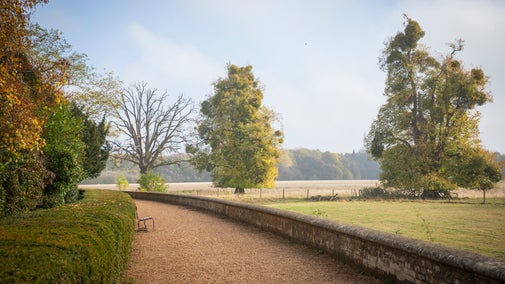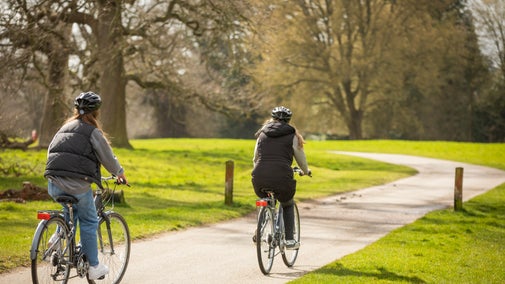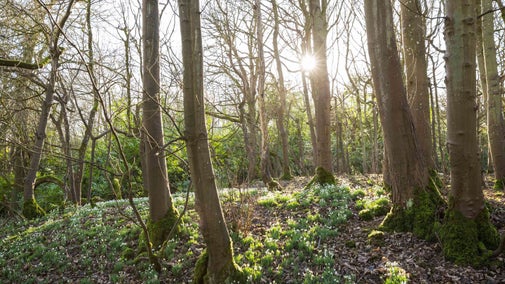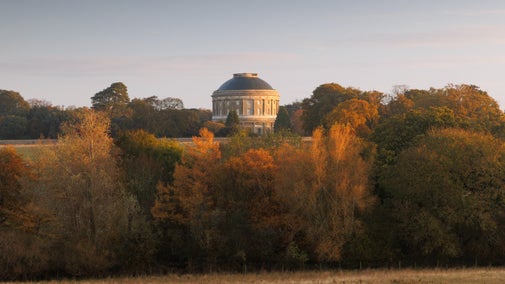
Discover more at Ickworth
Find out when Ickworth is open, how to get here, the things to see and do and more.

Ickworth is encircled in layers of history, landscape, people and classic architecture. Explore the parkland, designed for privacy, space and freedom with personal pathways, hidden glimpses and snatches of inspiring views.
Ickworth is a unique county estate created from a personal and passionate vision of classical Italy brought to Suffolk, never fully discovered and unforgettable. Elizabeth Percy, the Duchess of Northumberland, visited in the late 18th century and writes about the park in her diary:
- Elizabeth Percy, Duchess of Northumberland
Some of the woodland has the status of ancient woodland, meaning that there have been trees on this site since at least 1600. Examples of ancient woodland can be found in Lownde, Twist and Dairy Woods.
In most of the woods the existing trees were retained and though the landscape of the estate looks natural, it has been subtly landscaped by generations of the Hervey family with the design influenced by classical Italy.
The 5th Earl of Bristol (the 1st Marquess) was particularly active in shaping the estate, and enhanced the park with encircling plantations named after family members or estate staff who worked on planting them. He was also making an investment for future generations in the form of valuable timber.
This legacy is still helping to support the estate today not only through timber sales and biomass fuel, but by providing inspiring views with a wide variety of tree species creating a patchwork of year-long colour.
You don’t need to wander far from the house before the space and freedom envelops you. The rolling landscape and surrounding woodland provide surprising glimpses of the distant monumental Rotunda and numerous perfect venues for a family picnic.
If you're visiting with children, take a stroll along the Albana Walk, a circular woodland route that includes a den-building area and a trim trail.
One of the first things you’ll notice when you visit Ickworth are the sheep, especially at lambing time. They've always been an important part of the estate; not only adding to the pastoral views, but a key part of the working estate, maintaining the grasslands and providing income.
Currently, there are two tenant shepherds on the estate.

From the terrace in the Italianate Gardens, look out for a glimpse of a tall monument peeking above the trees. Situated in a pasture field on the far side of the Estate, you can reach it by taking a long walk across open land and through Lownde Wood.
The monument was erected in 1817 by the grateful people of Derry to the memory of the 4th Earl of Bristol, Frederick Hervey who was also the Bishop of Derry. It was built by the masons John and Robert de Carle and has inscriptions in both English and Latin on its east and west faces.
On the west face, it describes the Earl Bishop’s work in encouraging a better understanding between the warring factions in Ireland.
It's an unusual monument, as it was paid for by both the Protestant and Catholic communities in Derry.

The parkland today continues to thrive as a working estate and pleasure ground, continuing its long history established by the generations of the former owners, the Hervey Family.
Enjoy walks, runs, cycle rides and picnics across the parkland. Designed by the Herveys for their private recreation and refreshment, it is now used by everyone as a place to explore, enjoy and rediscover.

Find out when Ickworth is open, how to get here, the things to see and do and more.
Discover the house and the treasures collected by the flamboyant 4th Earl of Bristol at Ickworth, a magnificent Italianate palace in the heart of Suffolk.

Ickworth Estate is a three pawprint rated place. Let your four-legged friends lead you on a voyage of exploration around miles of parkland, offering new and exciting discoveries.

Ickworth's garden was the first of its kind in the UK. Designed for privacy, space and freedom, it's a distillation of the gardens of classical Italy given an individual English touch.

Find out more about cycling at Ickworth, including the cycle hire hub available in the car park. Pack a picnic and start your adventure.

Treat yourself in one of the cafés at Ickworth with a variety of tasty treats, light snacks and hot and cold drinks. Or grab a bargain as a souvenir of your visit in the shop or Plant Centre.

Plan a visit to one of the special countryside places in our care and discover the benefits of being in the great outdoors. Pack your walking boots and get ready to explore woodlands, valleys and rivers.

Explore the varied landscape of Suffolk, including heathland, an Anglo-Saxon burial ground and scenery made famous by the landscape artist John Constable.

Explore some of the finest landscapes in our care on coastal paths, accessible trails, woodland walks and everything in between. Find the best places to walk near you.
